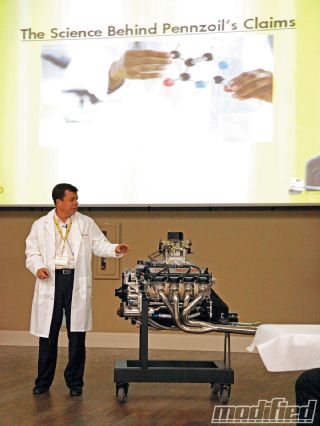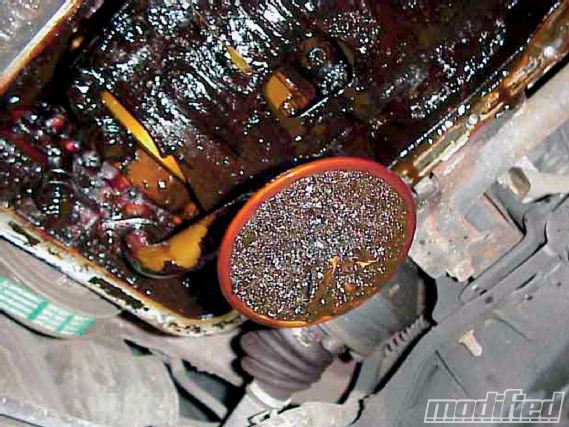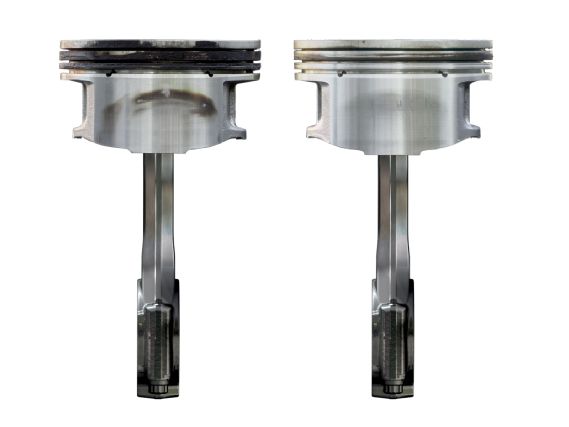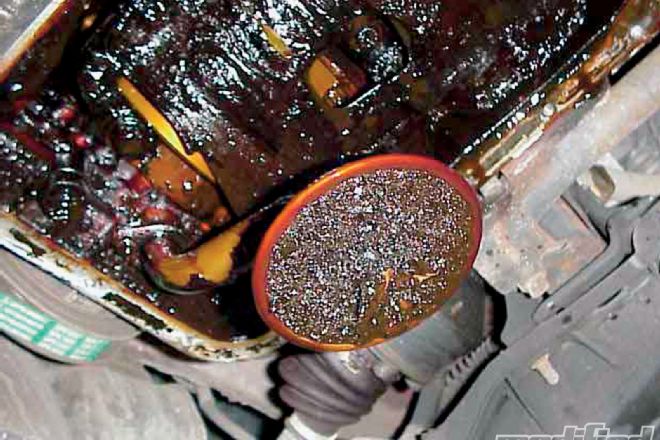While writing this month's SEMA Action Network story (page 20) and taking a look at the 2016 CAFÉ standards for fleet-wide fuel economy that all the automakers are busily working toward meeting, it seemed fitting to dedicate this month's Tech Talk to an important but oftentimes overlooked piece of that puzzle: motor oil.
 |
Dr. Robert Sutherland of Pennzoil isn't just one of the world's leading engine oil chemists, he also helped develop the new GF-5 standard that will be adopted industry wide starting October 1, 2011.
|
Dr. Robert Sutherland of Pennzoil isn't just one of the world's leading engine oil chemists, he also helped develop the new GF-5 standard that will be adopted industry wide starting October 1, 2011.
Whether you're aware of it or not, your engine's oil isn't just there as a lubricant designed to reduce friction on moving parts. It also plays an important role when it comes to fuel economy and emissions control, not to mention enabling advancements in engine design.
The latest minimum performance standard in passenger car motor oil, called ILSAC GF-5, is scheduled to take effect right about the time you read this (fall of 2010) and will be the factory fill for many 2011 model year engines. Starting in October of next year, GF-5 motor oil will be the required minimum standard for all gasoline engines (OEMs are always free to require more).
What are the ILSAC GF-5 specifications for motor oil, and how is it an improvement over ILSAC GF-4 spec oil? To answer these questions, I called Dr. Bob Sutherland, chief Pennzoil scientist at Shell Global Solutions and one of the world's leading motor oil chemists. Dr. Sutherland is also a member of the GF-5 negotiating team, where he helped define this new standard for motor oil.
According to Dr. Sutherland, "With respect to fuel economy, we always want more. For GF-5, we have a new fuel economy test, where we run the engine for 16 hours and make a fuel economy measurement. This is considered the fresh oil test. Then we age the oil [for 100 total hours or an estimated 4,000 to 6,000 miles] and redo the fuel economy test, which gives us an idea of how fuel economy changes as the oil ages. For GF-5 we have higher standards for both fresh oil fuel economy and aged oil fuel economy versus GF-4."
In general, GF-5 lubricants deliver 1-2 percent improvements in fuel economy. As Dr. Sutherland pointed out, "Some of the fuel economy improvement is the result of using a lighter viscosity, but it's important to always run the specified viscosity level for your engine since it was carefully engineered to run it. If you use a lower than recommended viscosity oil in search of improved fuel economy, you run the risk of increased wear in critical areas of the engine."
 |
Sludge buildup is one of the performance-robbing elements that GF-5 oil is designed to reduce, the result of which is more consistent oil flow and overall engine performance.
|
Sludge buildup is one of the performance-robbing elements that GF-5 oil is designed to reduce, the result of which is more consistent oil flow and overall engine performance.
ILSAC GF-5 isn't just about improved fuel economy, though. Improved oil robustness, where the oil better protects the engine from deposits and wear, has also been a focus of this new standard. According to Dr. Sutherland, "GF-5 robustness testing looks at sludge formation, varnish formation and resistance to carbon deposits on the pistons and rings. Moving from GF-4 to GF-5, we've really raised the bar on reducing sludge and piston deposits, since these are two of the most critical areas when it comes to engine performance. Sludge can cause blockages in oil flow to VVT devices, and it can also block the oil pickup screen or plug the oil filter, so reducing sludge is always a good thing. Limiting piston deposits as much as possible is also very important to overall engine operation, because as soon as deposits start to form on rings, ring grooves or ring lands, you really start to lose power and fuel economy. You lose the ring seal and as well as oil flow between the rings, which can lead to wear problems or even engine failure if a ring gets stuck and snaps. So keeping pistons clean is very important."
A third but equally important part of the development of the GF-5 standard for motor oil has to do with emissions system protection. Dr. Sutherland explained, "The amount of sulfur that's permitted in gasoline has come down significantly in order to protect catalytic converters and burn cleaner. In the search to limit sulfur emissions further, its use is being limited in motor oil as well. There's also a desire for a stricter limit on the amount of phosphorus, balanced, of course, protecting engines from wear. So with the new GF-5 standard, if you can't limit phosphorus content in motor oil, then you have to develop ways of keeping it in the oil and out of the exhaust flow. New chemistry has been developed to make phosphorus less volatile, which better protects the emissions system by keeping it where it belongs: in the oil."
 |
Combating carbon deposits like those seen on the piston on the left, especially in the critical ring land and ring groove area, is also a big part of the new GF-5 standard.
|
Combating carbon deposits like those seen on the piston on the left, especially in the critical ring land and ring groove area, is also a big part of the new GF-5 standard.
Emulsion testing is also an important part of GF-5 compliance, due largely to concerns about exotic fuels like E85 getting into the oil. As Dr. Sutherland explained, "GF-5 testing in this area is done to ensure that the oil can tolerate some fuel contamination without loss of performance. There's also seals testing done to ensure that GF-5 oil works well with new and old engine seals and gaskets, such as valve stem seals and front and rear main crankshaft seals. We have to be certain that the oil gets along well with any newly developed elastomers used to make seals."
The final key stipulation for all GF-5 oil is that it be backward compatible. As Dr. Sutherland stated, "This is a core issue, since we don't want owners of older vehicles to be unable to use the new GF-5 oils. We therefore must ensure that all of the requirements put into GF-5 are equal to or superior to GF-4, GF-3, GF-2 and so on, so that it's always backward compatible. This way, even if your owner manual says to use GF-4 oil, you're safe to go up to the next category, just like you're safe to go up from conventional oil to a synthetic blend to full synthetic oil. You never want to go down in spec, so if you buy a new car with an engine built specifically for GF-5 oil, don't run GF-4 in it."
With GF-5 becoming the new minimum performance level for engine oil starting on October 1, 2011 (and appearing on shelves starting this October), there's a lot of collaborative work going on at the moment between engine makers and oil makers. This kind of collaboration will no doubt lead to more efficient engines and longer lasting and better performing engine oils, the end result being a win for the consumer who gets a more fuel-efficient, cleaner-burning and longer-lasting engine. So when you see the ILSAC GF-5 designation showing up on motor oil containers at your local gas station or auto parts store, don't be afraid to put it to the test - it'll be the most advanced and best performing oil you've ever used.

